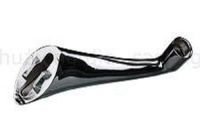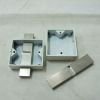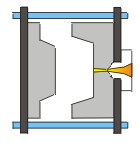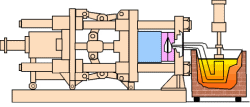The Process of Hot Chamber Zinc Castings
In the hot chamber zinc casting process, slabs of zinc are liquefied inside a furnace with a temperature of approximately 700-800 degrees Fahrenheit. When melted, the zinc metal stays in the furnace. The gooseneck or shot sleeve is immersed in the hot chamber and the molten zinc is injected into the two die halves being held together by the machine. The two halves of the die casting molds are mounted on the die casting machine and the machine shuts off and clamps the two die halves together. The molten zinc metal is under high pressure until such time that the metal solidifies (approximately less than a minute). Die halves then open up and the part or parts are ejected and taken out either manually or automatically. Finishing works include trimming, tumble deburring, precision machining, painting, anodizing, chrome plating and assembly.
Hot chamber zinc casting machines are used mainly for zinc, lead, magnesium, copper and other low melting point alloys that do not easily erode metal furnace pots, plungers and cylinders. The injection mechanism of a hot chamber zinc casing machine is soaked in the molten metal bath of a metal holding furnace. The furnace is connected to the machine by a metal feed system called gooseneck or shot sleeve. As the injection cylinder plunger goes up, a port in the cylinder opens, permitting hot molten metal to enter into the cylinder. As the plunger moves downward, it shuts the port and forces molten hot metal into the gooseneck and nozzle into the die cavity. When the metal has already solidified in the die cavity, the plunger is removed, the die opens and the casting is ejected.
Die Casting Zinc Company specializes also in Zinc lighting Castings.
Look at this webpage for
zinc cast part prices. Email us at Sales@DieCastingZinc.com

American Die Casting Company.
Sponsored Listings:







